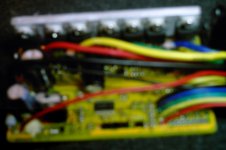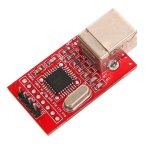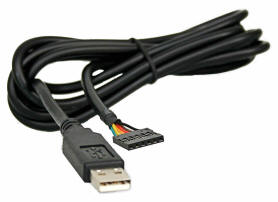Knuckles
10 kW
There are really only two meaningful pcb hardware mods for the Infineon IMO.bbsux said:Is there anything of interest that I can change with the config program?
1) Alter the power resistor circuit to allow "Any Voltage" (aka Transistor Mod)
and
2) Alter the R12 MCU circuit to alter the LVC and the maximum regenerative braking voltage.
All other controller functions can be addressed in the Infineon software.
The "Transistor Mod" is a subject in and of it self and I'll leave that to another thread.
The R12 "tweak" is pretty easy to explain so I'll describe that here.
R12 Circuit
A pin out on the MCU connects to the surface mount R12 resistor and then to ground. The stock Infineon R12 value is 1200 ohm. The MCU pin out is fed a tiny amount of current from other resistors on the controller board but the value of R12 dominates the actual pin out voltage for any given battery voltage. With R12 at 1200 ohm, the MCU pin out will vary between about 1 to 6 volts depending on varying battery voltages (20V to 90V) as provided from the thin red (or thin orange) controller battery (+) “ignition†wire.
The MCU reads the R12 voltage as a way to “know†the battery voltage at any point in time. The MCU is programmed with the assumption that R12 = 1200 ohm. Altering the R12 value will “trick†the MCU. This is the basis of the original variable LVC potentiometer that was used BEFORE I got my hands on the software interface.
The controller MCU “sets†the LVC based on the R12 pin out voltage.
BUT …
The MCU (apparently) CAPS the maximum regen braking voltage based on the R12 voltage also. It appears that the Infineon was “hard†programmed with a maximum regen braking voltage of about 60 volts. The max regen voltage value is apparently fixed at 60V and cannot be changed with the software interface (it would be nice if the max regen voltage changed when the software LVC is changed ... but this does not seem to happen).
But changing the R12 value is very easy to do. Adding another resistor from the underside of the board can lower R12. R12 can also be disabled (by drilling a small hole) and replaced with an all-new resistor value or a potentiometer (also from the underside of the board). More details about the R12 circuit are found here ...
http://endless-sphere.com/forums/viewtopic.php?f=16&t=7361#p110932
Changing R12 will change BOTH the LVC AND THE MAX REGEN braking voltage.
Lowering the R12 resistor value below 1200 ohm INCREASES the "real" LVC.
(and also increases the max braking voltage above 60V)
Increasing the R12 resistor value above 1200 ohm DECREASES the "real" LVC.
(and also decreases the max braking voltage below 60V)
EXAMPLE
Install a 2880 ohm in parallel to R12. R12(new) now equals 847 ohm.
1/R12(new) = (1/1200) + (1/2880), R12(new) =847
Now if you program the LVC to say 20.1 volts, the “real†LVC becomes 28.5 Volts
(20.1v) x (1200) / (847) = 28.5v
AND
The “real†max regen voltage becomes 85 Volts
(60v) x (1200) / (847) = 85 Volts
This is exactly how I got the Infineon to regen brake my 72V NiMH battery packs.
Works real nice too!




